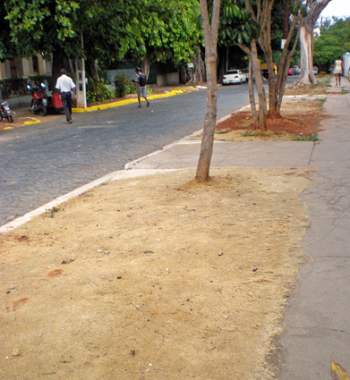Cuba Receives Some Much Needed Rain
Isbel Diaz Torres

The first rains arrived, and with them the great May drought came to its end. The impact on the water supply put a severe strain on the population. However, now I’m thinking about the plants.
It’s true that the shortage of water that affected wide regions of the country has negatively impacted nearly a half million people. This is distinctly visible in the Cuban capital, which has suffered the worst drought in a half century. The longer it lasted, the more the underground reserve sources diminished, the more pumping decreased and the more citizens suffered from the lack of service.
But today the afternoon is beautiful. It’s the third consecutive day of rain here, and already color is returning to the flower beds and gardens. Hail even fell on the San Agustin neighborhood, where I live. It makes me glad to see that the hot yellows will give way somewhat to fresh green tones.
I leaned out of a window and I thought of Jose Marti, of some of his inexpert verses as a youth (almost a child): “Love, mother, homeland, / it’s not a ridiculous love of the earth, / nor of the grasses that strangle our plants.” Marti was mistaken. It’s also that love of the earth, of the filling out of mint in a building’s garden; it’s that thinking of roots moving into the depths.

Of course, later Marti reveals his true message: “It’s the invincible hatred of those who oppress / it’s the eternal bitterness against those who attack.” It seemed that Marti “sweated” hatred through his blood (to use a somewhat silly phrase that I heard). Yet it was great that he was like that.
But returning to plants, the effects were visible. From only January to early April of this year, more than 400 forest fires were recorded in Cuba affecting more than 13,000 acres of forests and 5,800 of grassland marshes.
Somewhere around I’ve read that the economic losses last year due to fires in wooded areas rose to more than 7.6 million pesos ($342,000 dollars), though I wonder how they came up with those figures. How is the loss of biological diversity measured?
A few weeks ago I went to the La Coca reservoir, to the east of the capital, where I could witness an appalling site: a hillside that was entirely burnt. The saddest thing is to know that this is a protected area. Many plant and animal species endemic to Cuba flourished there, where they should have a refuge. The reality is that they’re condemned to disappear from the combined action of drought and the human intervention that causes fires.
A very informed and sensitive worker from there admitted to me that this was a practice of some residents who — with the intention of growing grass for their goats — would burn the forest. It was a sad spectacle, the same as seeing the reservoir that was almost empty from the lack of precipitation.
The delay in the rainy season has caused a situation whereby 38 water sources across the country are empty today. It’s well known the impact these dams have on obstructing the advance of rivers and springs, as well as their ability to contain gigantic volumes of water. Animal life and vegetation on the other side remain waiting for the liquid that we humans guard for ourselves.
To diminish that impact, there exist certain measures such as maintaining a constant flow of water leaving the reservoir. Nevertheless, what I saw in La Coca was laughable; barely a few frogs could survive with that amount of water forming puddles at the exit of the reservoir.

If that happened in an area protected by the Cuban government, I wonder how it would be in other areas. At the end of April a huge forest fire damaged some 6,230 acres of land in Holguin Province, in northeast Cuba. The flames could only be suffocated thanks to the first rains of May. The fire damaged the Pico Cristal and the La Mensura-Piloto national parks, located in the Mayari river basin.
I hope that the application of the “Early Warning System against Forest Fires” truly helps. Through this the analysis of satellite images are carried out, as has been widely promoted in the official press.
I’ve also been able to verify the impact of the drought through my ceiba tree plantings. The two that my family and I sowed near our house have lost all their leaves. Fortunately, with sporadic irrigation they’ve been able to keep their apical buds intact. That guarantees that, following this rain, they will be able to sprout again.
In short, we need more water. Forecasts indicate that the rain between June and October might not be enough to compensate for growth deficiencies in many areas of the country. Hopefully this is a miscalculation, as often occurs. In any case, plants are more efficient than us, fortunately.






Comments are closed.